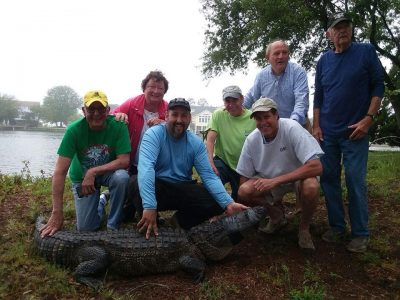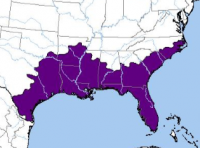KITTY HAWK – This Outer Banks community was abuzz last week at the sighting of a nearly 10-foot-long alligator in a neighborhood canal on the western tip of town, an area that rarely, if ever, has been visited by the huge reptiles.

“It is the northern extent of alligator range,” said Alicia Davis, a wildlife diversity biologist with the North Carolina Wildlife Resources Commission. “We do hear from folks in Kill Devil Hills or Manteo once or twice a year.”
Supporter Spotlight
After a team from Coastal North Carolina Alligator Research was called to the scene on May 7, the animal was caught, measured and released back into the same canal, likely to move on to a quieter spot.
But with the prospect of having the ancient predator as a new neighbor, it’s not a stretch to see why some may favor North Carolina’s recent action that lifted its 45-year ban on alligator hunting in some counties.
The flipside, Davis added, is that when there’s more alligators hanging out in canals and sunning themselves in backyards – such as near Lake Waccamaw in Columbus County – the more people learn to co-exist with them.
“Actually, in that community, by and large, most residents are used to seeing alligators,” she said. “It’s going back decades.”
Still, Davis advised numerous nervous callers from Kitty Hawk to keep their pets inside or on leashes, especially between dusk and dawn, and to use common sense with children.
Supporter Spotlight
“Generally, it’s just a matter of if you leave them alone, they’ll leave you alone,” she said, with the caveat that their instincts should not to be taken lightly. “An alligator wouldn’t know the difference from a possum and a pet dog.”
Even though the community of Alligator, the Alligator River and the Alligator River National Wildlife Refuge, with its vast swamplands crisscrossed by murky canals, are in the rural northeastern counties of Dare and Tyrrell, the names and wetland habitat give the wrong impression. Alligator sightings in much of the northeast, especially on the barrier islands, are a novelty.
For years, a big male alligator known as “Cheeseburger” became an attraction in late spring to people driving past a canal off U.S. 64 in mainland Dare County. Drivers would pull off the highway to gape at the reptile cruising slowly in the dead-still canal or sunning itself on its banks. One year, the alligator reportedly chased a terrified man who strayed too close.
Cheeseburger was struck and killed by a minivan in 2014. Biologists with the refuge later determined it was 12 feet long and weighed 672 pounds.
In general, alligators prefer fresh to brackish waters, but they’ll put up with salt water for short periods. And as cold-blooded creatures, they don’t like cold temperatures.
Beyond the newsworthy adventure last week in Kitty Hawk, alligators have lately received more attention than usual in North Carolina. In February, the North Carolina Wildlife Resources Commission approved the state’s first alligator management plan. Under that plan, it is now legal for the first time since 1973 to hunt the animals, on a limited basis.
The new management strategy provides that a permit for “population reduction hunts” can be requested by cities, towns and villages within Brunswick, Carteret, Columbus, Craven, Hyde, Jones, New Hanover, Onslow, Pamlico and Pender counties to kill one alligator per season between Sept. 1 and Oct. 1. The permit request would be required to include an assessment of alligator numbers, areas of public safety concern and identification of areas where alligators could be safely hunted.
As of Friday, Davis said, no applications had been submitted. The deadline to apply is June 1.
Interest in hunting alligators primarily came from residents in Brunswick, New Hanover and Columbus counties, where there is a large population of alligators, said Allen Boynton, Wildlife Diversity Program Coordinator for the commission. The agency set up a task force in 2016 to develop an alligator management plan and determine the feasibility of a conditional hunting program.
Public input about the proposed plan, in addition to 328 submitted comments, included opposition to alligator hunting expressed in 648 standardized emails and by eight different organizations. In response, the agency scaled back hunting in the final plan to nuisance situations in the counties with high numbers of alligators. The limited hunting availability would allow more time for researchers to study the alligators’ habitat and population, with a goal of sustainable practices.
Some typical calls the agency receives, Boynton said, involve such nuisances as alligators blocking traffic or taking a dip in a swimming pool. Sometimes, on a hot summer day, an alligator might park in the shade under a car or chill out in a garage. Usually people are advised to be patient and the animal will most likely leave on its own accord. Wildlife agents who are qualified to relocate alligators can remove the animals, he said, but it’s rarely necessary. Most relocations have been done in Brunswick and New Hanover counties.
Despite their fierce appearance and intimidating size – males, far bigger than females, can grow as large as 14 feet in length and weigh more than 500 pounds – alligators are very intelligent and are by nature shy of people. They can become dangerous if they’re accustomed to being fed by people, which is against the law.
Not surprisingly, alligators are more likely to be aggressive if a female is protecting her young, Alligators are remarkably good reptilian mothers who guard their eggs, help their hatchlings in the nest and keep watch over their young for about two years.
“If you approach the nest or the young, yes, she will be defensive,” Davis said. “It’s intimidating.”
While doing a survey in Oak Island in Brunswick County, Davis found herself facing an angry alligator mom when she inadvertently got too close to her hatchlings at the water’s edge.
“She put her tail and head up out of the water and made a really loud hissing noise,” Davis recalled. “A smart person would take the hint.”

The animals range in the southern U.S. from south Texas to the northern edge of North Carolina and can live 50 years in the wild. But not much is known about alligators in North Carolina, including their movements, their lifespans or, most importantly, their population. With the state’s cooler temperatures, the animals mature as much as 10 years later than they do in the warmer states. The chillier temperatures also cause development of a preponderance of male hatchlings.
Outright alligator attacks or threats, said Boynton, are more likely where populations of people and alligators are high and their territories overlap, such as in Florida. And the powerful animals are no slugs, even when running.
“The way that alligators catch their prey is by ambush,” he said. “So, they are capable of moving very quickly. They can move over a short distance quite fast. They are opportunistic predators.”
Compared to their evolutionary ancestors, today’s alligators are like cute little lizards. Among fossils dating back 231 million years, a fossil of an early alligatoroid unearthed during the Civil War era in Bladen and Sampson counties revealed that it measured 8 meters, or 26 feet long, and weighed about 2.3 tons.
Scientists say that American alligators have lived in North America for 7 million years. But it’s worth noting that the species has descended from crocodiles that survived the Jurassic extinction period that wiped out those not-so-tough dinosaurs.
Modern overhunting, mostly for alligator skins, coupled with habitat loss, however, almost did them in. Under different versions of international, federal, and state protections in place since 1966, the alligator population has largely recovered. It remains listed as threatened under the Endangered Species Act.
Davis said that there is not yet enough data available to determine whether North Carolina alligator populations are robust enough to sustain losses from hunting and future habitat losses from human encroachment, saltwater intrusion from sea level rise, and overall effects of climate change.
The management plan calls for long-term surveys, monitoring and research of alligator populations.
No assessment of the alligator population has been done in the state for more than 30 years, when the highest numbers were observed in the southern Cape Fear watershed, according to a June 2016 article published in the Journal of Herpetology, “Factors Affecting Occupancy and Abundance of American Alligators at the Northern Extent of Their Range.” Monitoring has been minimal in North Carolina, the article said, but it appears that the shorter growing seasons restricts breeding, nesting and hatching, more so in colder periods and locations. There are also indications of decreasing alligator populations in South and North Carolina.
Most surveys have depended on night spotlighting, which uses light to find reflections from the alligators’ eyes – an imperfect mechanism that can result in duplicative counting. Other surveys have been done during the day or by aerial counts. The more accurate, but difficult and costly, survey method involves examination and tagging or marking of the alligators.
Davis said that scientists with Coastal NC Alligator Research, agroup that responded to the sighting last week in Kitty Hawk, were the first since the 1970s to do physical surveys of alligators in North Carolina. Led by Steve Dinkelacker, a professor at Framingham State University in Massachusetts, the team has an Endangered Species Act permit issued by the commission that allows the researchers to capture alligators, measure them, determine their sex by examining a cavity under the base of the tail and sample their scute, one of the ridges along the tail. By law, the animals must be released where they were found. Since the studies in the Albemarle peninsula began in 2011, she said, Dinkelacker and his team have captured and released about 80 alligators, mostly in Hyde County.
Last year, Davis said, Wildlife Commission biologists collaborated with the University of Georgia to capture, examine and tag alligators at Lake Waccamaw. With the program conducted again this April with North Carolina State Parks, she said, passive integrated transmitter, or PIT, tags, similar to microchips in pets, were inserted into a total of 53 alligators living near the lake.
The agency is also working on a program that would provide PIT tags to its wildlife agents who relocate nuisance alligators, she said.
Davis said that at least six research projects are planned to learn more about North Carolina’s alligators.
“It’s not just the numbers – it’s also about the status of the population,” she said. “Knowing whether the population is stable or decreasing or increasing is really important to know whether you can sustainably harvest them.”
Front page featured photo: Gil Grant/North Carolina Wildlife Resources Commission







